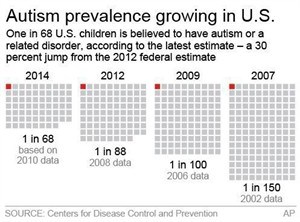
Graphic compares prevalence in children with autism or related disorders since 2007; 2c x 2 1/2 inches; 96.3 mm x 63 mm;
March 27, 2014 - 11:49 AM
NEW YORK, N.Y. - The government increased its autism estimate on Thursday to 1 in 68 U.S children.
That's a 30 per cent jump from the last federal estimate of 1 in 88 children with autism or a related disorder. The latest calculation means autism is more than twice as common as officials said it was just seven years go.
But health officials say the new number may not mean autism is occurring more often. Much of the increase is believed to be from a cultural and medical shift, with doctors diagnosing autism more frequently, especially in children with milder problems.
There are no blood or biologic tests for autism, so diagnosis is not an exact science. It's identified by making judgments about a child's behaviour.
This latest estimate by the Atlanta-based Centers for Disease Control and Prevention means autism affects roughly 1.2 million U.S. children and teens.
The CDC report released Thursday is considered the most comprehensive on the frequency of autism. Researchers gathered data in 2010 from areas in 11 states — Alabama, Arizona, Arkansas, Colorado, Georgia, Maryland, Missouri, New Jersey, North Carolina, Utah and Wisconsin.
The report focused on 8-year-olds because most autism is diagnosed by that age. The researchers checked health and school records to see which children met the criteria for autism, even if they hadn't been formally diagnosed. Then, the researchers calculated how common autism was in each place and overall.
The CDC started using this method in 2007 when it came up with an estimate of 1 in 150 children. Two years later, it went to 1 in 110.
For decades, autism meant kids with severe language, intellectual and social impairments and unusual, repetitious behaviours. But the definition has gradually expanded and now includes milder, related conditions.
___
Online:
CDC: http://www.cdc.gov/ncbddd/autism/index.html
News from © The Associated Press, 2014